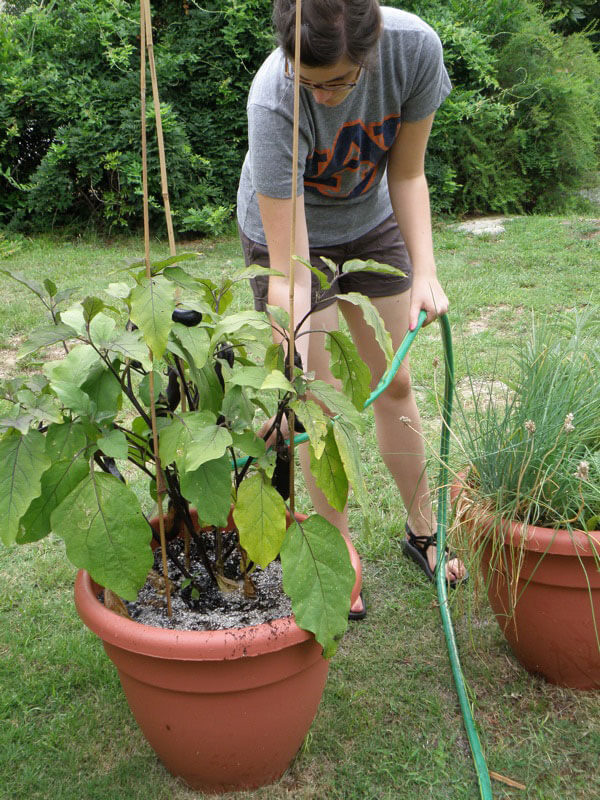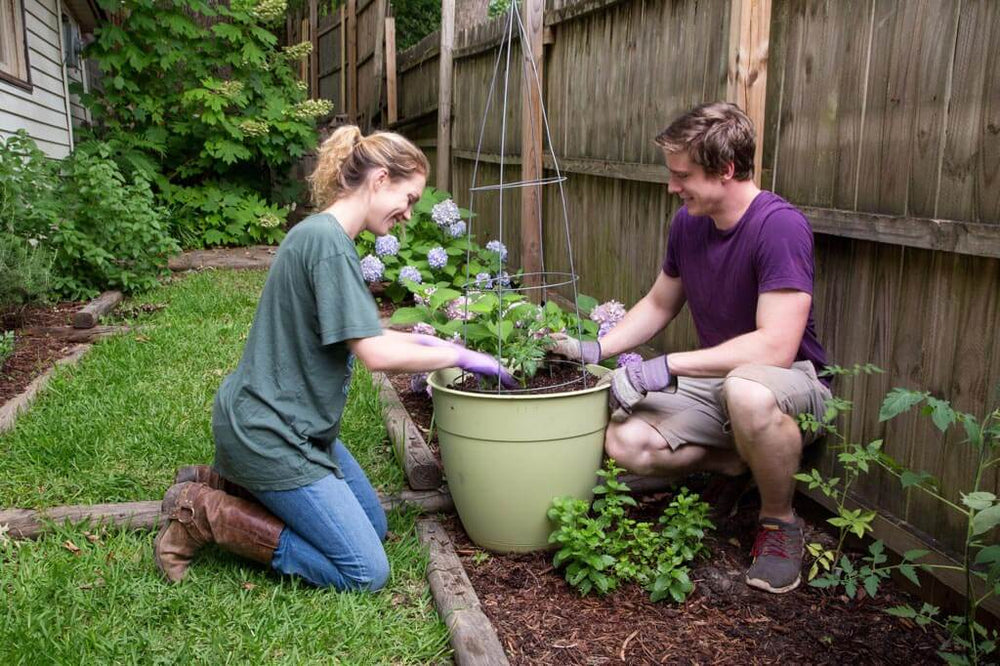Every new gardener makes mistakes, like planting mint and geraniums together in a window box (who knew that mint bullies everything in its path?) or choosing the "perfect" planting spot in early spring, only to see it covered in shade after the trees leaf out.
Don't be discouraged! We're here to help so you can enjoy growing your own food without getting frustrated. Read on to learn some of the most common mistakes made by beginner gardeners—and how to avoid them.
1. Putting your garden out of sight
Planting your vegetables and herbs in a lonely backyard corner may help hide it from your homeowners association (HOA), but it will hide it from you, too. That makes it easy to forget to check for droopy plants that need water, miss the early signs of pests, or neglect to harvest regularly.
Do this instead: Plant your garden where it's hard to miss—outside the kitchen door, along a walkway you frequent, or near the back patio. You'll be able to spot thirsty plants or bug damage quickly, before major harm occurs to your crops. Plus, a convenient garden makes it easier to harvest a handful of basil to add flavor to your meal or to enjoy a healthy snack of cherry tomatoes as you pass by. (If needed, check out these ideas for gardening with an HOA.)
2. Planting too much
After spending the winter creating elaborate gardening Pinterest boards, thumbing through seed catalogs, and dreaming of fresh veggie flavor, it's easy to overestimate how big your garden should be—and underestimate the time and effort it will take to care for it. Experienced gardeners know that a big garden equals a big commitment, one that's too much for most new gardeners.
Do this instead: Start small. If you're a total newbie to gardening, make a list of your five favorite vegetables and herbs. Then take a little time to research their growing needs before you buy them. (Our How to Grow section is a great reference tools for this.) When you're ready to plant, choose Bonnie Plants® to get your garden off to a strong, fast start. Not only are our young plants vigorous and already well on their way to maturity, but you'll have our company's more than 100 years' of growing experience behind you. Add a few more plants and a bit more growing space each year and before you know it, you'll have plenty of homegrown produce to share!
3. Planting too soon (or too late)
One of the biggest mistakes new gardeners make can be chalked up to cabin fever. On the first warm day after being cooped up inside all winter, you head straight outside and plant a row of tomatoes...and then nighttime temperatures plummet back below freezing and you lose them all. On the other hand, you don't want to wait too long to plant, either. Planting when it's already hot can stress plants and require a lot more effort from you to get them to harvest.
Do this instead: First, find out your region's estimated first and last frost dates here, then use those dates as a guide to when to start your garden. After all, who wants to waste time and money planting a garden twice, just because you were teased by a warm, spring-like day? If you're anxious to get your hands dirty after a long winter, busy yourself building a raised bed, adding garden paths, or improving your garden soil until the danger of frost passes.
4. Planting in just any old soil
What's so wrong with digging up some dirt and putting the plants in? Plenty. See, soil provides the foundation for a successful garden, so it needs to be rich and filled with nutrients. Bad soil is like junk food for plants, and they won't grow and thrive if they're stuck in it—just like you wouldn't do well if all you ate were potato chips!
Do this instead: Before planting, improve your in-ground soil with nutrient-rich Miracle-Gro® Garden Soil for Vegetables and Herbs, which helps protect against both under- and over-watering. If you're growing in containers, you'll need a lighter weight soil with excellent drainage, like Miracle-Gro®Potting Mix. For raised beds, Miracle-Gro® Raised Bed Soil is a smart choice, as it will provide your plants with just the right texture and blend of nutrients for great growth.

5. Planting where there's not enough sun
You may love tomatoes, but if you don't have a spot that gets at least 6 to 8 hours of sunlight, you won't have much luck growing them. It's a basic—and sometimes frustrating—fact of gardening: You'll waste time, money, and effort trying to grow sun-loving plants in shady spaces.
Do this instead: If your yard is on the shady side, consider growing sun-loving plants in containers and placing them in whatever sunny patch is available, whether that's a patio, balcony, or driveway. Just use as many pots as you need to create the garden you want. (Visit our Container Gardening section for lots of helpful tips.) Another option is to choose vegetables and herbs that tolerate partial shade, like lettuce, kale, Swiss chard, spinach, parsley, and thyme. Check the tag that comes with each Bonnie Plant® to see how much sunlight it needs.
6. Crowding your plants
As a new gardener, it's tempting to try to grow lots of plants in your garden to maximize your harvest—and besides, those little plants look so lonely with no friends around them. Here's the thing, though: Small plants will grow bigger, and as they do, they're going to need more space. Too many plants crowded in a small area means they're going to have to compete for water and nutrients, jeopardizing the health of the entire garden. Plus, if there isn't enough air circulation between plants, any diseases that come along will have an easier time spreading.
Do this instead: Follow the recommended spacing found on each Bonnie Plants® plant tag, on the plant variety pages in the vegetables and vegetables sections of our website. And don't worry—your plants won't look little or lonely for long.
7. Planting far from a water source
Moisture is one of the biggest plant needs, but there are few things less exciting than having to lug heavy watering cans or drag a long, unwieldy hose across the yard to give the garden a much-needed drink. The usual result? Your plants don't always get all the water they need.
Do this instead: If you can, position your garden near a water source. Or, if you have to plant elsewhere because of sun needs, consider installing a rain barrel near the garden to make watering easier. To know when it's time to water, check the dryness of the soil by sticking your finger in it. When the top inch is dry, water deeply and thoroughly, aiming water at the base of the plants to avoid splashing water on the leaves (which can lead to disease). For more information, check out these tips for watering your garden, plus this article for some creative drought-busting techniques that include using soaker hoses or drip irrigation to lighten your watering load.

8. Not feeding your plants
When you're starting out, it's easy to forget that plants need food, too. Sure, if you improved the soil at planting time, your garden will have good nutrition to start, but even the best soil will eventually run short of nutrients to feed your hungry plants if you don't replace them.
Do this instead: Well-fed plants grow stronger and provide better harvests, so feed yours regularly with plant food specially designed for veggies and herbs, like Miracle-Gro® Water Soluble Plant Food for Vegetables and Herbs. It feeds instantly to help you get a bigger harvest (vs. unfed plants), and you can do it while you water so it doesn't take any extra time. Be sure to follow the directions on the label.
9. Forgetting to harvest
When you're a beginner gardener, it can be tricky to know when your plants are ready to harvest—and if you wait too long, you could end up with an overgrown yellow cucumber or basil that starts to flower and turn bitter. It can be a challenge, too, to know when to pick colorful veggies that branch beyond the standard green pepper or red tomato.
Do this instead: Visit our How to Grow page for the type of plant you're growing to learn what to look for when it comes to harvest time. You can also check the picture on the plant tag to see what the plant (and fruit) should look like when it's ripe. Then, be sure to walk your garden every day. Just 24 hours can be the difference between a zucchini at the peak of perfection and one that's the size and consistency of a baseball bat. Now that you know what sorts of mistakes garden newbies tend to make, you'll have a much better chance of avoiding them—even if you're technically a beginner yourself. So get out there and have fun growing a beautiful, delicious first garden!




 Herbs
Herbs
 Vegetables
Vegetables
 Fruit
Fruit
 Flowers
Flowers
 Succulents
Succulents


